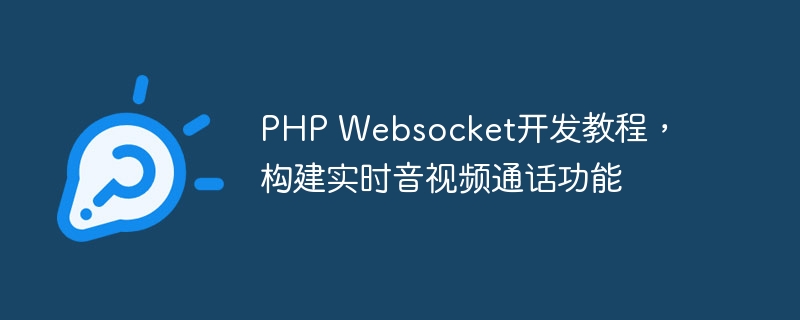Home >Backend Development >PHP Tutorial >PHP Websocket development tutorial to build real-time audio and video call function
PHP Websocket development tutorial to build real-time audio and video call function
- WBOYWBOYWBOYWBOYWBOYWBOYWBOYWBOYWBOYWBOYWBOYWBOYWBOriginal
- 2023-12-18 14:04:57884browse

PHP Websocket development tutorial, building real-time audio and video call function
Introduction:
Real-time audio and video call is one of the very common and important functions in modern Internet applications one. As a widely used server-side language, PHP can also realize the function of real-time audio and video calls by using Websocket technology. This article will introduce how to use PHP to develop a Websocket server, and demonstrate how to build a real-time audio and video call function through specific code examples.
-
Install Websocket server dependency package
First, we need to install a PHP Websocket library to help us create a Websocket server. One of the most popular libraries is Ratchet. The Ratchet library can be easily installed using Composer:composer require cboden/ratchet
-
Creating a Websocket server
Next, we need to create a PHP file as the entrance to the Websocket server. In this file, we need to introduce the Ratchet library and create a Websocket server object. The sample code is as follows:<?php require 'vendor/autoload.php'; use RatchetMessageComponentInterface; use RatchetConnectionInterface; use RatchetServerIoServer; use RatchetHttpHttpServer; use RatchetWebSocketWsServer; class VideoChat implements MessageComponentInterface { protected $clients; public function __construct() { $this->clients = new SplObjectStorage; } public function onOpen(ConnectionInterface $conn) { // 添加新连接到客户端列表 $this->clients->attach($conn); echo "New connection! ({$conn->resourceId}) "; } public function onMessage(ConnectionInterface $from, $msg) { // 处理客户端发来的消息 foreach ($this->clients as $client) { if ($client !== $from) { $client->send($msg); } } } public function onClose(ConnectionInterface $conn) { // 从客户端列表中移除已关闭连接 $this->clients->detach($conn); echo "Connection {$conn->resourceId} has disconnected "; } public function onError(ConnectionInterface $conn, Exception $e) { echo "An error has occurred: {$e->getMessage()} "; $conn->close(); } } $server = IoServer::factory( new HttpServer( new WsServer( new VideoChat() ) ), 8080 ); $server->run(); -
Front-end page connects to Websocket server
In the front-end page, we need to use JavaScript to connect to the Websocket server and send audio and video data. The following is a simple sample code:let webSocket = new WebSocket('ws://localhost:8080'); // 连接成功 webSocket.onopen = function() { console.log('Connection established.'); } // 接收消息 webSocket.onmessage = function(event) { let message = event.data; // 在这里处理接收到的音视频数据 } // 发送音视频数据 function sendVideoData(data) { webSocket.send(data); } -
Implementing audio and video processing logic
In the Websocket server, we can implement audio and video processing by processing the audio and video data sent by the client. Video calling feature. For example, we can use the FFmpeg library to encode and decode audio and video data, and the OpenCV library for image processing, etc. The following is a simple sample code that demonstrates how to process audio and video data:// 在VideoChat类中添加以下方法 public function processVideoData($videoData) { // 在这里处理音视频数据 } public function processAudioData($audioData) { // 在这里处理音频数据 } public function onMessage(ConnectionInterface $from, $msg) { $data = json_decode($msg); $type = $data->type; $payload = $data->payload; switch ($type) { case 'video': $this->processVideoData($payload); break; case 'audio': $this->processAudioData($payload); break; default: // 处理其他类型的数据 } }
Summary:
Through the above steps, we successfully developed a Websocket server using PHP and demonstrated Learn how to build real-time audio and video calling capabilities. Of course, this is just a simple example, and more details and complexities need to be dealt with in actual applications. But through this tutorial, readers can have a preliminary understanding of PHP Websocket development, and can conduct more in-depth study and practice on this basis.
Reference materials:
- Ratchet documentation: http://socketo.me/
- FFmpeg official website: https://ffmpeg.org/
- OpenCV official website: https://opencv.org/
The above is the detailed content of PHP Websocket development tutorial to build real-time audio and video call function. For more information, please follow other related articles on the PHP Chinese website!

